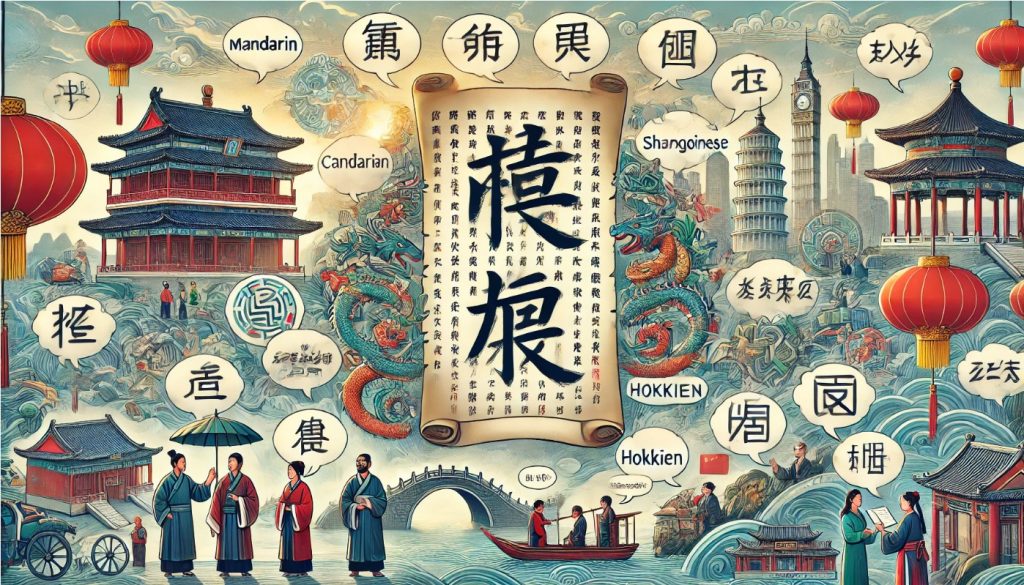The Chinese language, one of the oldest and most widely spoken languages in the world, is deeply intertwined with the history, culture, and philosophy of China. While the term “Chinese” typically refers to Mandarin, the standard language spoken by over a billion people, the reality is far more complex. Chinese comprises a range of dialects, each with distinct characteristics, histories, and cultural significance. Understanding the diversity of the Chinese language, including its written form, pronunciation, and variations, provides insight into the cultural richness of the Chinese-speaking world.
The Structure of the Chinese Language
At its core, Chinese is a language that is often considered non-phonetic and non-alphabetic, which makes it unique compared to many other languages. Rather than using an alphabet to represent individual sounds, Chinese uses a system of logograms—characters that each represent a word or a meaningful part of a word. This writing system has evolved over thousands of years and is used in different ways depending on the region and context.
The Written System of Chinese Characters
Chinese characters, known as hànzì (汉字), are the foundation of the written language. These characters are logograms, each one representing a concept, word, or morpheme (the smallest meaningful unit in a language). Over time, the character system has developed into two major forms: simplified and traditional characters.
Simplified Chinese Characters
Simplified characters were introduced by the government of the People’s Republic of China in the 1950s as part of an effort to increase literacy rates. These characters are derived from the traditional forms but feature fewer strokes, making them easier to write and memorize. Simplified characters are now standard in mainland China, Singapore, and Malaysia, while traditional characters are still used in Taiwan, Hong Kong, and Macau.
Traditional Chinese Characters
Traditional Chinese characters retain the complex forms used for thousands of years and are still favored in areas with deep cultural and historical ties to the older writing system, such as Taiwan and Hong Kong. While the characters may appear more complicated, they often retain more historical and etymological meaning than simplified forms, and many cultural and academic fields continue to use traditional characters.
The Role of Pinyin
Pinyin (拼音) is the Romanization system used to represent the pronunciation of Chinese characters in the Latin alphabet. Developed in the 1950s, it serves as a tool for teaching pronunciation and is the official system for writing Mandarin in China, Taiwan, and overseas. Pinyin has become essential for students of Chinese, as it allows learners to understand how characters should be pronounced and is used in Chinese dictionaries, language teaching, and computer input systems.
Mandarin: The Standard Chinese Language
Mandarin is by far the most spoken language in the world, with over 900 million native speakers. It is the official language of the People’s Republic of China, Taiwan, and Singapore, and one of the six official languages of the United Nations. While Mandarin is often referred to as “Standard Chinese,” it is technically a group of closely related varieties of Chinese spoken in northern, central, and southwestern China.
The Phonology of Mandarin
Mandarin is known for its relatively simple phonetic system compared to other Chinese languages. It uses a system of four main tones, which are critical to distinguishing meanings between words that may otherwise be pronounced the same. The tones in Mandarin are:
- First tone: High and level, as in “mā” (妈) meaning “mother.”
- Second tone: Rising, as in “má” (麻) meaning “hemp.”
- Third tone: Falling and then rising, as in “mǎ” (马) meaning “horse.”
- Fourth tone: Falling, as in “mà” (骂) meaning “to scold.”
The importance of tones in Mandarin is essential for both verbal communication and understanding, as different tones can drastically change the meaning of a word.
The Vocabulary and Grammar of Mandarin
Mandarin, like other Chinese languages, is an analytic language, meaning that it relies more on word order and auxiliary words than on inflection or conjugation. This results in relatively simple sentence structures, where the subject-verb-object (SVO) order is followed. While Mandarin has no grammatical gender or verb conjugations, it uses a rich system of particles, word order, and tone to convey meaning.
Word Order and Sentence Structure
Mandarin follows a subject-verb-object word order, much like English, though this structure can be modified in more complex sentences. For example, negation in Mandarin often comes with a change in word order. Words like bù (不, “not”) or méi (没, “did not”) precede the verb, unlike in English where negation typically follows the auxiliary verb.
Measure Words and Classifiers
Mandarin also employs measure words or classifiers to count objects. These words are necessary to quantify nouns, which can vary depending on the type of object being counted. For example, the word for a book is 书 (shū), but to say “one book,” one must use the classifier 本 (běn) to say 一本书 (yī běn shū).
Chinese Dialects: A Complex and Diverse System
While Mandarin is the most widely spoken variety of Chinese, it is far from the only one. In fact, the Chinese language consists of a number of distinct dialects, many of which are not mutually intelligible. These dialects are often grouped into several major language families based on their geographical distribution and linguistic characteristics.
The Major Dialect Groups of Chinese
The Chinese language can be broadly divided into seven main dialect groups, which include a wide variety of regional languages that differ significantly in pronunciation, vocabulary, and grammar. These dialect groups include Mandarin, Cantonese, Shanghainese (Wu), Hokkien (Min), Hakka, Xiang, and Gan.
Mandarin Dialects
Mandarin is the most geographically widespread Chinese dialect and is spoken in the northern, northeastern, and southwestern parts of China. Despite its wide distribution, Mandarin itself can be divided into many local variations. The Beijing dialect, for example, is the basis of Standard Mandarin, but it shares similarities with dialects in Tianjin, Shanxi, and Inner Mongolia. As a result, Mandarin encompasses a range of accents and local variations.
Cantonese (Yue) Dialect
Cantonese is primarily spoken in the Guangdong province, Hong Kong, and Macau, as well as in overseas Chinese communities, particularly in Southeast Asia, North America, and Europe. Cantonese is known for its rich tonal system, which is more complex than Mandarin’s. Cantonese traditionally has six tones, though some sub-dialects feature as many as nine.
Cantonese also retains many features from older stages of the Chinese language, making it an important dialect for the preservation of traditional Chinese culture. For example, the spoken form of Cantonese preserves many words and expressions that have disappeared in Mandarin.
Shanghainese (Wu) Dialect
Shanghainese, belonging to the Wu language family, is spoken mainly in Shanghai and the surrounding region. Wu dialects, including Shanghainese, are known for their distinctive phonetics, including a lack of tones in some instances, a softer intonation compared to Mandarin and Cantonese, and a complex system of initials and finals.
Shanghainese and other Wu dialects are also characterized by their use of a wide variety of vowel sounds, which can make it challenging for Mandarin speakers to understand. The tonal system is quite different from Mandarin, with Shanghainese using pitch contours to distinguish meanings.
Hokkien (Min) Dialect
Hokkien, or Min, is a group of Chinese dialects spoken in the Fujian province, Taiwan, and by Chinese communities in Southeast Asia, particularly in Malaysia, Singapore, and the Philippines. The Hokkien dialect retains many archaic features that have been lost in other varieties of Chinese. The dialect is famous for its complex tonal system, which can have as many as eight tones depending on the local variant.
Hokkien vocabulary is also heavily influenced by historical contact with various Southeast Asian languages, including Malay and Indonesian. This makes it a vibrant and dynamic language, with words borrowed from these regional languages.
Hakka Dialect
Hakka is spoken by the Hakka people, a subgroup of Han Chinese. It is widely spoken in southern China, particularly in the provinces of Guangdong, Fujian, and Jiangxi, as well as by diaspora communities in Southeast Asia and around the world. The Hakka dialect, like Cantonese, has retained many older features from Middle Chinese, making it a valuable dialect for linguistic studies.
Hakka has a simpler tonal system compared to Cantonese, typically using six tones. The dialect is known for its rich history, as the Hakka people are historically known for their migrations and for establishing their own cultural identity in various regions of China.
Xiang and Gan Dialects
The Xiang dialect, spoken primarily in the Hunan province, and the Gan dialect, spoken in Jiangxi province, are less well-known compared to Mandarin or Cantonese, but they are still significant in their respective regions. Both dialects have complex tonal systems and retain many features from earlier stages of the Chinese language.
The Xiang dialect, for example, has both lower level tones and rising tones, while Gan dialects often exhibit pronunciation characteristics that are close to those of Mandarin, but with distinct tonal and phonetic features.
Mutual Intelligibility Among Dialects
One of the most important aspects of the Chinese language is the lack of mutual intelligibility among its various dialects. Although these dialects share a common written form, the spoken forms can be so different from one another that speakers of different dialects often cannot understand each other. For instance, a native speaker of Mandarin would likely find it difficult to understand Cantonese, Shanghainese, or Hokkien.
Despite this, the common written system and the widespread use of Mandarin as the national standard have allowed speakers of different dialects to communicate in writing and in formal contexts.
The Spread and Globalization of the Chinese Language
In recent decades, Mandarin has become one of the most studied and spoken languages in the world, largely due to China’s growing political and economic influence. Many non-Chinese-speaking countries, particularly in the West, are now offering Mandarin courses in schools, and there is an increasing number of people learning Chinese as a second language.
The global spread of Chinese is further enhanced by the rise of Chinese diasporas in regions such as Southeast Asia, North America, and Europe. These communities continue to maintain their local dialects, while also incorporating Mandarin in education, business, and communication.
Chinese Communities Around the World
Chinese-speaking communities are spread across the globe, from Chinatowns in major cities to entire regions in Southeast Asia where Chinese dialects like Cantonese, Hokkien, and Teochew are still spoken by millions. In these regions, Mandarin is often taught as a second language, but local dialects continue to play a central role in daily life and cultural practices.
The Chinese diaspora, particularly in regions such as Malaysia, Singapore, Indonesia, and the United States, maintains a linguistic and cultural connection to their ancestral roots. Chinese schools, media, and cultural events play an important role in preserving the dialects, even as younger generations increasingly speak Mandarin for practical reasons.







